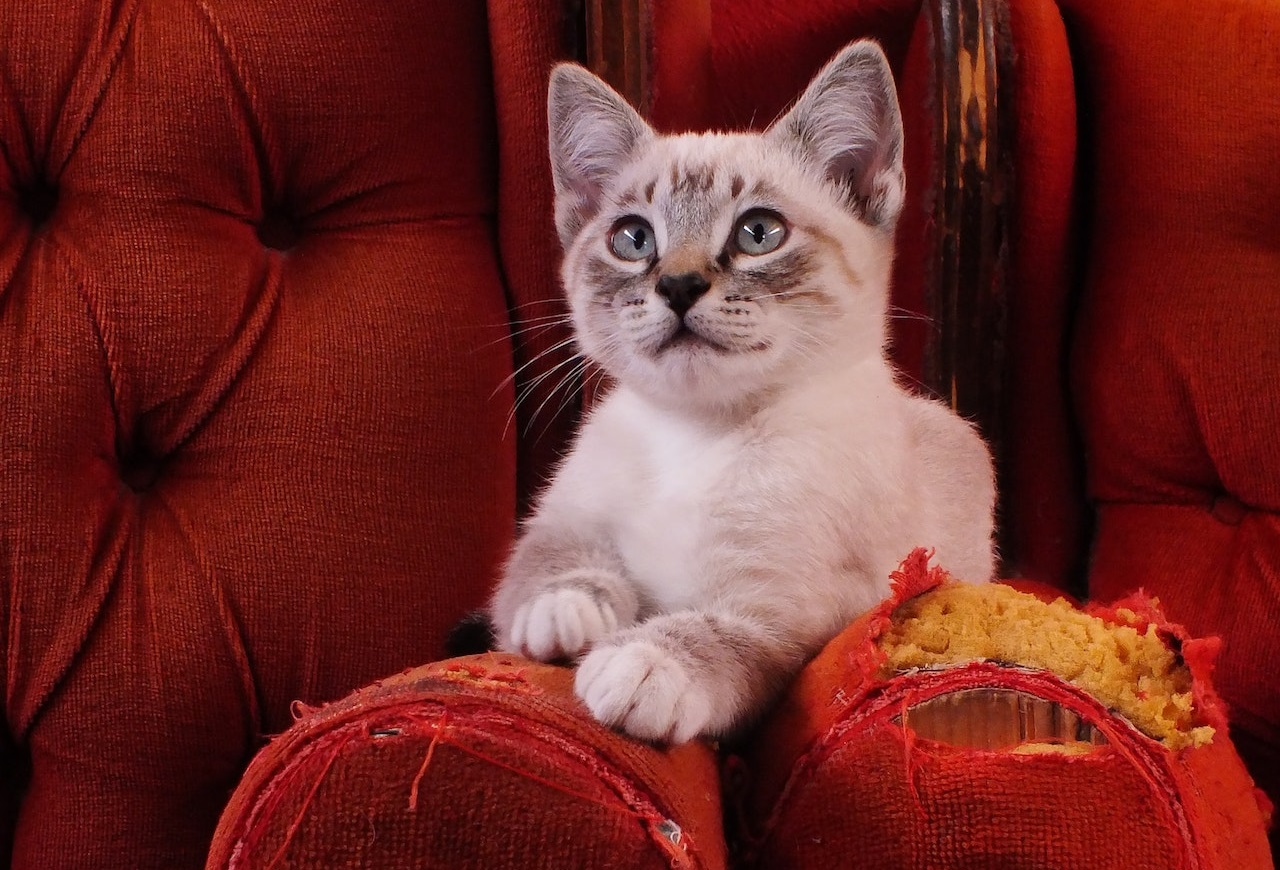So, you’ve got yourself a feline companion, and while you love their soft fur, heartwarming purrs, and the daily presentation of their butt, there’s just one small problem: your favorite sofa looks like it survived a fight with Freddy Krueger. Well, don’t fret, dear cat servant. I’m here to offer you some purrfectly amusing, but totally genuine advice on how to save your furniture from your cat’s adorable little murder mittens.
1. Declawing: The Ultimate No-No
First things first. You might think, “Why not just declaw them?” Ah, yes. And why not remove your fingers while we’re at it? Declawing is like amputating the last bone of each of your fingers. It’s inhumane, painful, and can lead to behavioral and health problems for your furry overlord. So, unless you fancy being branded an evil villain in your cat’s life story, avoid this route. Remember, if cats could write memoirs, you don’t want an entire chapter dedicated to your atrocities.
2. Invest in a Scratching Post (Or Ten)
You know what’s cheaper than buying a new couch every six months? A scratching post. Cats are just looking for something to dig their claws into, and if you provide them with a far less expensive and expendable piece of furniture, they might just take you up on that offer. If you’re lucky, they’ll use it. If not, well, you now have a new piece of modern art to explain to your guests.
Pro-tip: Make sure the scratching post is stable. Cats dislike wobbly posts. If it topples over, your cat might just give you the stink eye and return to your beloved armchair as an act of revenge.
3. Placement is Key
Cats aren’t just being jerks when they scratch your furniture. Often, they’re marking their territory (because clearly, the whole house is theirs). Placing a scratching post near their favorite furniture-targets can divert their attention. But, who am I kidding? Placing a scratching post everywhere is probably your safest bet. Turn your house into a cat’s jungle gym. Your cat might just start to think you’re cool.
4. Double-Sided Tape: Your New Best Friend
Cats hate sticky things. You know, like the feeling you get when you step on something suspicious at the movie theater. Double-sided tape on the edges of your furniture can deter those sneaky paws. Just be prepared for some very judgmental glares from your feline as they try to figure out what sorcery you’ve employed.
5. Sprays and Deterrents:
There are sprays available that can deter cats from scratching. No, it’s not like spraying water (which, by the way, will just earn you a spot on your cat’s hit list). These sprays have a smell that cats dislike but are harmless. Of course, you could always DIY with a mix of water and essential oils like rosemary or citrus, but remember, the smell needs to be unpleasant for the cat, not you. Unless you’re into that kind of thing.
6. “Soft Paws” to the Rescue
So, your cat thinks it’s the latest sensation in the nail fashion world, but those pointy claws are wreaking havoc on your furnishings. Consider investing in some claw caps, also known as “Soft Paws”. These are nifty little caps that can be glued onto your cat’s claws, rendering them scratch-safe. They come in various colors, so you can turn your furball into the most fashionable cat on the block. Sure, Fluffy might give you some disdainful looks for a few hours, but at least your furniture is safe (and stylish).
7. The Ancient Art of Cat-Training
Who said cats can’t be trained? Alright, almost everyone said it, but they’re only partly right. With some patience, you can train your cat to understand that the couch is not their personal scratching pad. Every time they approach the couch with that familiar gleam in their eye, redirect them to the scratching post. Reward them with treats and affection when they make the right choice. It’s like bribing them, but in a loving, “please-don’t-destroy-my-furniture” kind of way.
8. Frequent Nail Trimming – A Spa Day for Kitty!
Cats hate this, but regular nail trims can reduce the damage they cause. So, get a pair of cat nail clippers, arm yourself with patience, and get ready for an afternoon of drama. Or take them to a vet or groomer if you’re not confident. It’s like getting a manicure, but with more hissing involved.
9. Introduce Distractions
Cats are curious creatures. Sometimes, all it takes to save your furniture is a shiny new toy or a laser pointer. Get them chasing after something else, and they might just forget about that delectable corner of your sofa for a while. Look for toys that engage their hunting instincts; they’re especially irresistible!
10. Acceptance: Embrace the Chaos
Finally, if all else fails, just embrace the chaos. Sure, your home might not grace the cover of “Furniture Monthly”, but it’s filled with love, cat hair, and slightly damaged belongings. Remember, perfection is overrated. And in the grand scheme of things, wouldn’t you rather have a happy cat and a scratched sofa than the other way around?
So there you have it! A semi-comprehensive, slightly sarcastic guide to keeping your furniture safe from your feline overlord. Remember, every scratch tells a story, and every piece of furniture is just another chapter in the epic tale of life with a cat. Cherish it, laugh about it, and maybe, just maybe, invest in some good furniture covers. Happy cat-herding!
Bonus Pro Tips: For Those Who Love Their Furniture and Their Felines
- Rotate the Fun: Just as we humans get bored of our toys (or, you know, that exercise bike that’s now a clothes rack), cats too can grow uninterested in their toys. Rotating them out every few weeks can keep things fresh and exciting for your cat, diverting their attention from your furniture.
- Create Vertical Spaces: Cats love to climb. If you provide them with tall cat trees, shelves, or even wall-mounted paths, they may be too busy being the kings and queens of their new castle to bother with your couch.
- Herbal Distractions: Products like catnip or silver vine can be a great distraction. Sprinkle some on their scratch posts to make them more appealing.
- Use Furniture Protectors: These are thin sheets or covers specifically designed to protect your furniture from pet damage. They’re typically less noticeable than double-sided tape and can save you from the “sticky situation”.
- Reinforce Positive Behavior: Every time your cat uses their scratching post or plays with their toys, reward them. Whether it’s a small treat, some affectionate petting, or verbal praise, positive reinforcement can work wonders.
- Set Boundaries Early: If you’ve just brought a new kitty home, start training early. The younger they are, the more adaptable they tend to be. However, remember that old cats can learn new tricks, so don’t despair if your feline is a bit older!
- Consult a Professional: If you’ve tried all the tricks in the book and your cat is still set on redecorating your home their way, consider seeking advice from a professional cat behaviorist.
- Furniture Materials Matter: When shopping for new furniture, look for materials that are less appealing to cats. Microfiber, for instance, is often less enticing than other fabrics for scratching. It’s not foolproof, but every bit helps!
- Keep Their Claws Busy: Cardboard boxes are not just memes on the internet. Cats genuinely love them! They’re perfect for scratching, playing, and napping. They might not be the prettiest addition to your home décor, but they’re cheap and replaceable.
Remember, understanding and patience are your best tools in this adventure. At the end of the day, your cat isn’t scratching to spite you (probably), but rather it’s a natural instinct. By providing alternatives and positive reinforcement, you’re creating a win-win situation: a happy cat and a slightly less scratched-up home!
Frequently Asked Questions: Protecting Furniture from Feline Fury
Cats scratch for various reasons: to mark their territory, shed old claw sheaths, stretch their bodies, and simply because it feels good. It’s not a personal vendetta against your furniture, even if it sometimes feels that way.
It’s more effective to redirect and reward than to punish. Cats don’t understand punishment the same way dogs might. Yelling or spritzing them with water can make them fearful or confused, and they might not associate the punishment with the act of scratching.
Cats can be fussy about the texture and placement of their scratching posts. Ensure you offer a variety of materials and place them near their favorite scratching spots on the furniture. Also, make sure the posts are sturdy; cats dislike wobbly posts.
Every 10-14 days is a good rule of thumb, but this can vary based on the cat’s age, activity level, and individual growth rate.
Yes, when applied correctly, claw caps can be a safe and effective solution. Make sure to pick the right size for your cat and check periodically to ensure they’re not causing any discomfort.
No, some essential oils can be toxic to cats. Always research and ensure the oil you’re using is safe for felines. Common cat-safe deterrents include rosemary and certain citrus oils.
Invest in interactive toys or timed feeders to keep your cat occupied when you’re not around. A bored cat is often a destructive cat.
For minor scratches on leather, a leather repair kit can be useful. For fabric upholstery, a fabric shaver can help remove fuzziness caused by scratching. Deep scratches might require professional attention or patching.
While kittens might be more malleable, cats of any age can be trained with patience and consistency. Start as early as possible, but don’t give up on older cats!
Consulting a professional cat behaviorist might provide insights specific to your cat’s behavior. Sometimes, unique problems require unique solutions.



